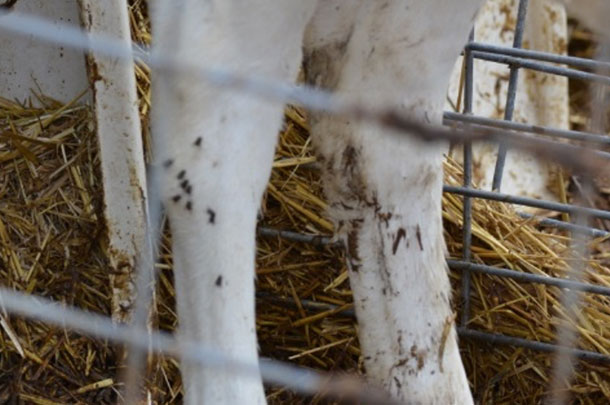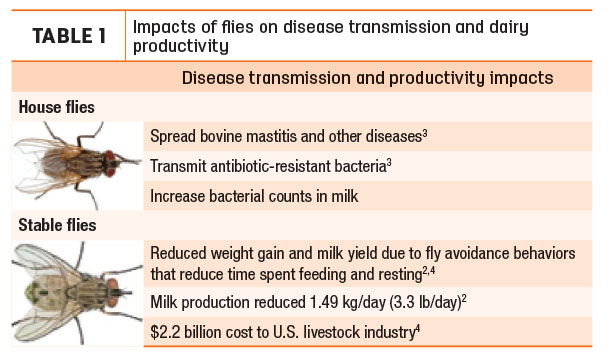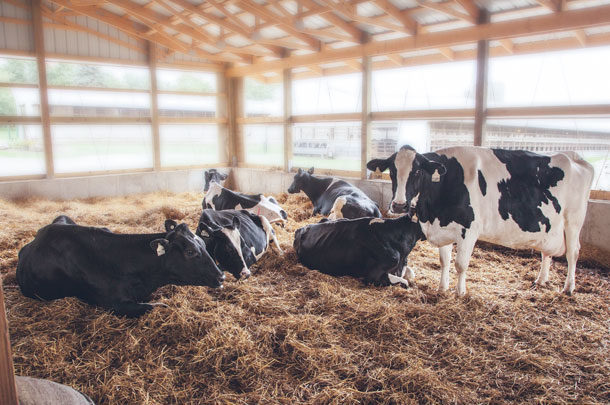Fly infestations on U.S. dairy operations cost the industry and individual farmers significantly in lost productivity and feed efficiency and increase the risk of disease.
The two principal fly pests responsible for this are houseflies (Musca domestica) and stable flies (Stomoxys calcitrans).
Houseflies can spread diseases by transporting disease-causing organisms on their leg hairs and mouthparts. Excessive fly populations are an irritant to farm workers and, when they are near human habitations, a potential public health problem.
Stable flies are about the size of a housefly, but the adult has piercing mouthparts that protrude from under its head for blood feeding. Cattle are irritated by these pests, which leads to reduced productivity.
Fly biological and behavior patterns
Houseflies lay eggs in organic material, including manure, and in decomposing material. When houseflies land on a surface, they vomit, defecate or both. A light-brown speck is a vomit spot, and a dark speck is a defecate spot. Stable flies lay eggs in wet straw and manure, spilled feeds, silage, grass clippings and various other types of decaying vegetation.
Cows stomping their feet is a good indication stable flies are present because they normally attack legs and bellies. Cattle are most irritated by stable flies during the summer. Production performance declines in infested herds because of the painful bites and the animals’ fatigue from efforts to dislodge the flies. Stable flies overwinter as larvae or pupae by burrowing in the soil under organic matter.
 Stable flies are pictured on young dairy calves. Two-and-a-half to five flies per leg reduce both weight gains and feed conversion efficiency in cattle. Photo provided by Elanco.
Stable flies are pictured on young dairy calves. Two-and-a-half to five flies per leg reduce both weight gains and feed conversion efficiency in cattle. Photo provided by Elanco.Disease transmission and impact on productivity
Houseflies pose a serious health hazard to people and animals by spreading numerous diseases in and around animal-rearing facilities and nearby residential areas. In dairy barns, house flies feed on milk leaking from the udders of diseased animals and spread diseases such as bovine mastitis to healthy cows.
Severe housefly infestations may increase bacterial counts in milk, and state inspectors routinely note the presence of flies in milk rooms.
Flies harbor and spread antibiotic-resistant bacteria on livestock farms, and controlling them can help reduce that spread. Fly control can reduce the spread of disease on farms and, as a result, reduce the need to use antibiotics to treat disease.
Stable flies will move to animals to bite and feed on blood approximately once per day. When counted this way, an average of more than five stable flies per cow is expected to have economic costs. For young cattle, weight gains can be considerably reduced and feed efficiency negatively affected.
The reduction in weight gain and milk yield is primarily due to animals exhibiting fly avoidance behaviors (such as cattle bunching) that reduce their time feeding or resting. Recent research has estimated that stable flies cost the U.S. livestock industry $2.2 billion annually.
When researchers released large numbers of stable flies in the vicinity of dairy stalls, milk production decreased by 3.3 pounds per day. Studies that measured weight gains in beef cattle exposed to stable flies in controlled environments indicate that at and above two-and-a-half to five flies per leg reduced both weight gains and feed conversion efficiency in feeder cattle.

Management systems and breeding sites
Common fly breeding sites include:
- Calf hutches, especially in corners and under water and feed buckets
- Silo leak and spill areas
- Animal stalls and pens; feed preparation, storage and manger areas; and areas near water sources
- Calf, hospital and maternity areas
- Water tanks
- Feed troughs
- Inside and outside manure-handling areas
Integrated pest management
Integrated pest management (IPM) is recommended for implementing a successful fly management program in and around dairies. Fly season varies by region and is dependent upon temperature and moisture. When adult flies are observed at the dairy, a management program should begin and continue to be implemented throughout the fly season.
Monitoring: Monitoring is an indispensable part of IPM. Several monitoring tools have been developed for adult and larval populations to enable farm managers to monitor for impending emergence of adult flies and provide a basis for timing and frequency of spray applications.
Sanitation: Sanitation removes fly breeding areas resulting in a reduction in larvae and viable areas for adults to lay eggs. Depending on the type of dairy facility, dry manure management is highly effective in reducing fly populations. Where applicable, frequent removal of manure prevents fly buildup by breaking the breeding life cycle. It is important to scatter manure lightly outdoors to kill eggs and larvae by drying. Don’t let spilled feed accumulate. Regulate water flow to dairy watering sources and prevent or repair any leaks. Provide adequate cross ventilation in the facility.
Ensure proper floor grading so excess surface water drains away from the facility. Eliminate drainage issues in exercise yards. Seal gaps under feed bunks where moist feed can accumulate. Cut grass and vegetation short to remove fly resting areas.
Mechanical control: Mechanical control involves the use of devices to control flies or remove manure. This may include physical exclusion with screens or fans to prevent entry into dairy houses, fly traps, electric insect killers and automatic scrapers to constantly remove manure from buildings.
Chemical control: Use of insecticides for fly control is an important component in an integrated fly control program directed at reducing fly populations to tolerable levels. Chemical use around lactating dairy animals is limited. Be sure to read and follow label directions.
Accurate records should be kept on chemicals and dosage rates used. Improper timing and indiscriminate insecticide use combined with poor manure management, poor moisture control and poor sanitation practices increase pest populations and the need for additional insecticide applications.
To manage potential insecticide resistance, avoid the unnecessary application of insecticides, use physical or biological control methods and conserve areas free of chemical treatments where susceptible pests survive.
In situations where pesticides become the only control tool, resistance management requires they be rotated between different chemical classes deploying different modes of action applied by different applications. Concurrent use of pyrethroids, organophosphates, neonicotinoids, spinosyns, insect growth regulators (IGRs) and other classes of insecticides is recommended.
IGRs can be used in conjunction with any adulticide application, as they are from different chemical classes using different modes of action. Only approved (registered) insecticides should be used, according to label directions.
Biological control: Biological control should be part of an overall fly control program in dairy operations. Practices may include provisioning for temporary manure-refuge of natural fly enemies, selective use of less toxic pesticides and manure moisture management at low levels – all with the intent to increase the efficiency of natural enemies.
Parasitoid wasps, predatory beetles and mites are used for control of juvenile stages of flies. In addition, several species of entomopathogenic nematodes have been studied for their potential as biocontrol agents.
Community issues
Residences closest to large-scale confined animal feeding operations (CAFOs) experience a much higher fly population than average homes. Conflicts between CAFOs and local residents have resulted in public health actions including litigation. As a result, CAFOs must develop and maintain a successful IPM program to reduce and control fly populations.
If fly control is a problem on your dairy farm, there are solutions available. Work with your local consultant to determine the best program for your farm.
References omitted but are available upon request by sending an email to the editor.







